CNA151: Reflective Paper on Health Promotion Using Driscoll's Model
VerifiedAdded on 2023/03/21
|6
|1597
|48
Essay
AI Summary
This essay employs Driscoll's Reflection Model to critically analyze the author's experience as part of a multidisciplinary team involved in a health sensitization program. The reflection focuses on a specific case involving a fifteen-year-old boy with type 1 diabetes, highlighting the importance of effective communication, inter-professional collaboration, and patient-centered care. The author reflects on their feelings during the experience, their learning points regarding health promotion and teamwork, and identifies areas for improvement in future practice, such as advocating for improved communication within the team and ensuring adequate time with each client. The essay concludes that using Driscoll’s model has provided valuable insights into handling diverse medical backgrounds and adhering to health promotion principles.
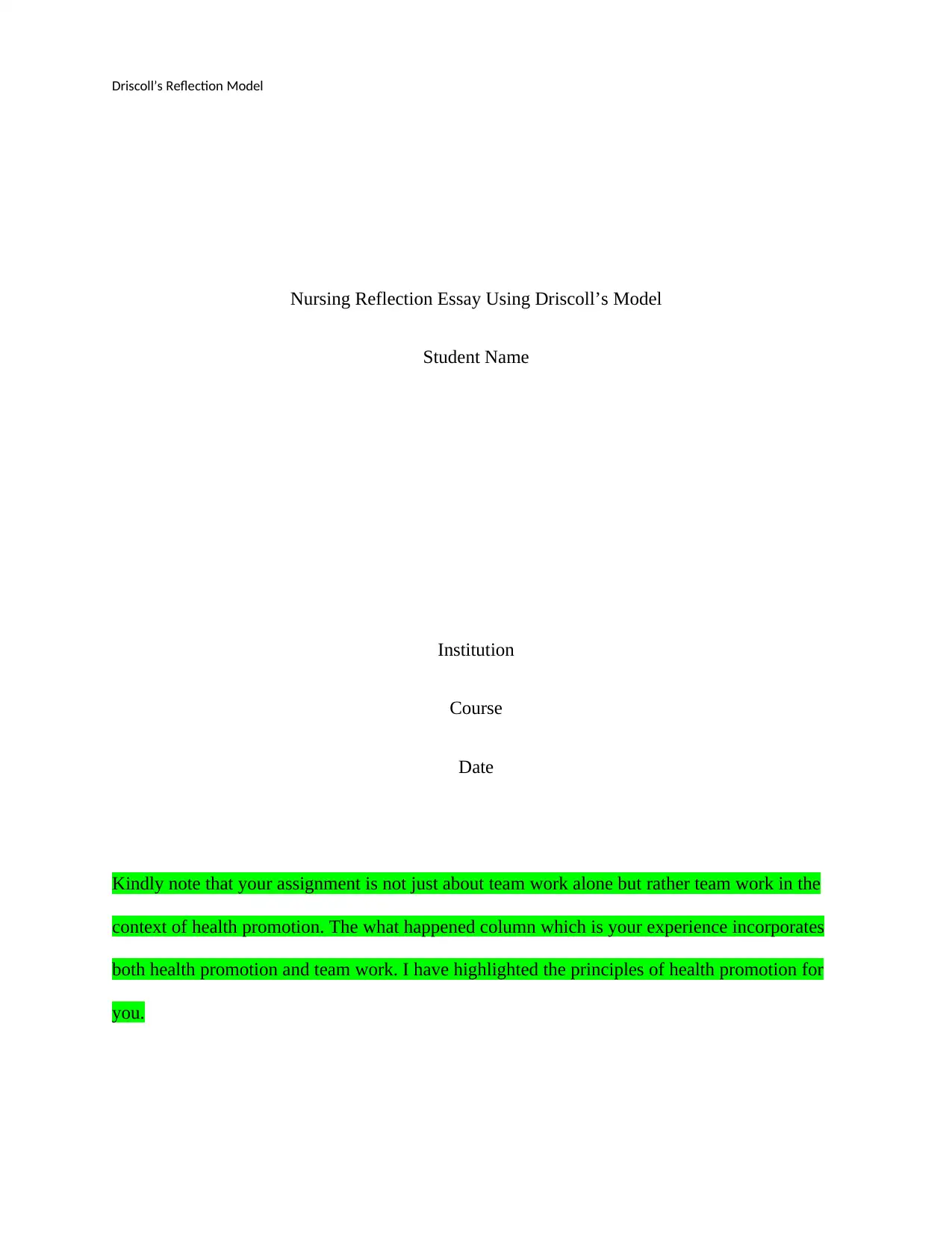
Driscoll’s Reflection Model
Nursing Reflection Essay Using Driscoll’s Model
Student Name
Institution
Course
Date
Kindly note that your assignment is not just about team work alone but rather team work in the
context of health promotion. The what happened column which is your experience incorporates
both health promotion and team work. I have highlighted the principles of health promotion for
you.
Nursing Reflection Essay Using Driscoll’s Model
Student Name
Institution
Course
Date
Kindly note that your assignment is not just about team work alone but rather team work in the
context of health promotion. The what happened column which is your experience incorporates
both health promotion and team work. I have highlighted the principles of health promotion for
you.
Paraphrase This Document
Need a fresh take? Get an instant paraphrase of this document with our AI Paraphraser
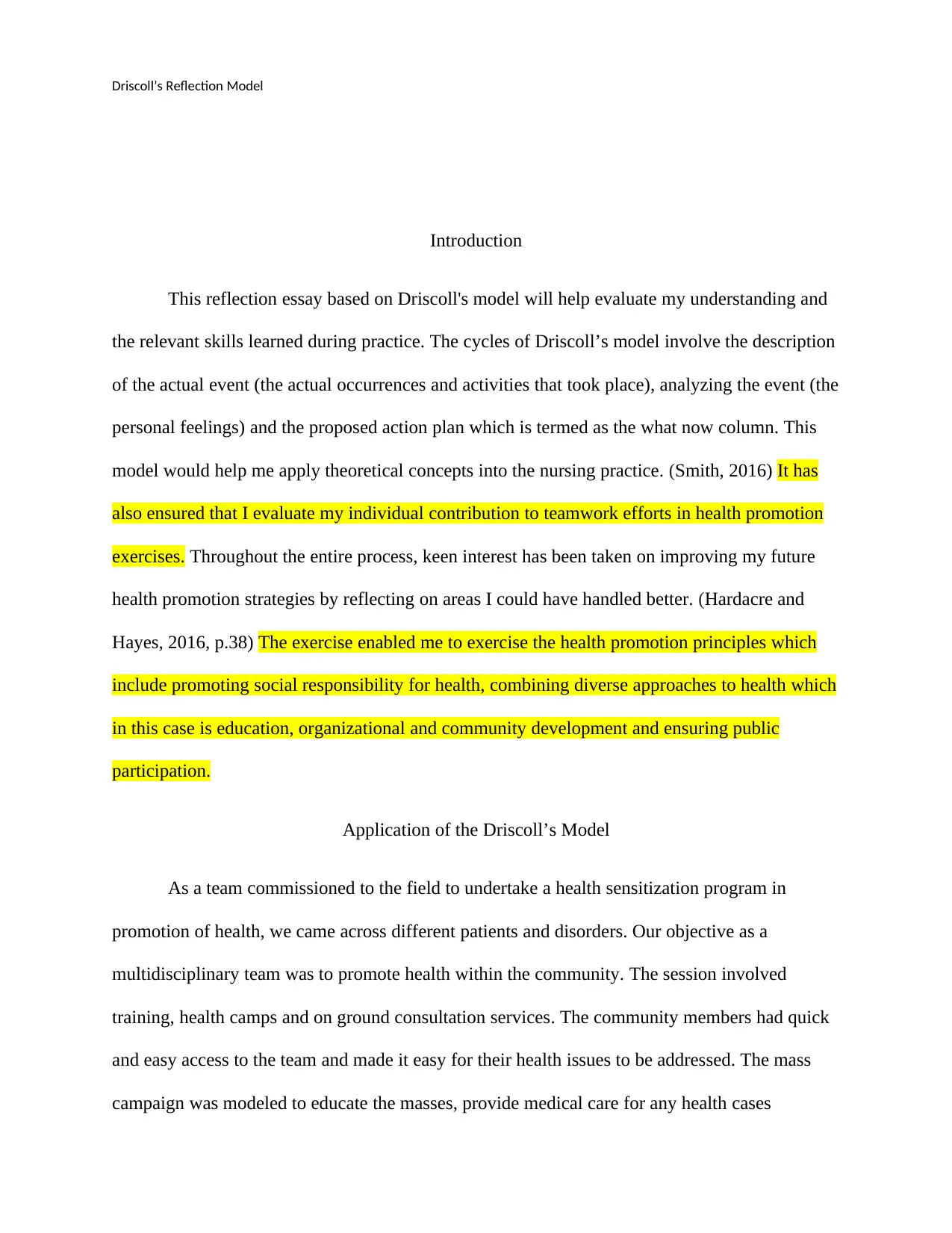
Driscoll’s Reflection Model
Introduction
This reflection essay based on Driscoll's model will help evaluate my understanding and
the relevant skills learned during practice. The cycles of Driscoll’s model involve the description
of the actual event (the actual occurrences and activities that took place), analyzing the event (the
personal feelings) and the proposed action plan which is termed as the what now column. This
model would help me apply theoretical concepts into the nursing practice. (Smith, 2016) It has
also ensured that I evaluate my individual contribution to teamwork efforts in health promotion
exercises. Throughout the entire process, keen interest has been taken on improving my future
health promotion strategies by reflecting on areas I could have handled better. (Hardacre and
Hayes, 2016, p.38) The exercise enabled me to exercise the health promotion principles which
include promoting social responsibility for health, combining diverse approaches to health which
in this case is education, organizational and community development and ensuring public
participation.
Application of the Driscoll’s Model
As a team commissioned to the field to undertake a health sensitization program in
promotion of health, we came across different patients and disorders. Our objective as a
multidisciplinary team was to promote health within the community. The session involved
training, health camps and on ground consultation services. The community members had quick
and easy access to the team and made it easy for their health issues to be addressed. The mass
campaign was modeled to educate the masses, provide medical care for any health cases
Introduction
This reflection essay based on Driscoll's model will help evaluate my understanding and
the relevant skills learned during practice. The cycles of Driscoll’s model involve the description
of the actual event (the actual occurrences and activities that took place), analyzing the event (the
personal feelings) and the proposed action plan which is termed as the what now column. This
model would help me apply theoretical concepts into the nursing practice. (Smith, 2016) It has
also ensured that I evaluate my individual contribution to teamwork efforts in health promotion
exercises. Throughout the entire process, keen interest has been taken on improving my future
health promotion strategies by reflecting on areas I could have handled better. (Hardacre and
Hayes, 2016, p.38) The exercise enabled me to exercise the health promotion principles which
include promoting social responsibility for health, combining diverse approaches to health which
in this case is education, organizational and community development and ensuring public
participation.
Application of the Driscoll’s Model
As a team commissioned to the field to undertake a health sensitization program in
promotion of health, we came across different patients and disorders. Our objective as a
multidisciplinary team was to promote health within the community. The session involved
training, health camps and on ground consultation services. The community members had quick
and easy access to the team and made it easy for their health issues to be addressed. The mass
campaign was modeled to educate the masses, provide medical care for any health cases
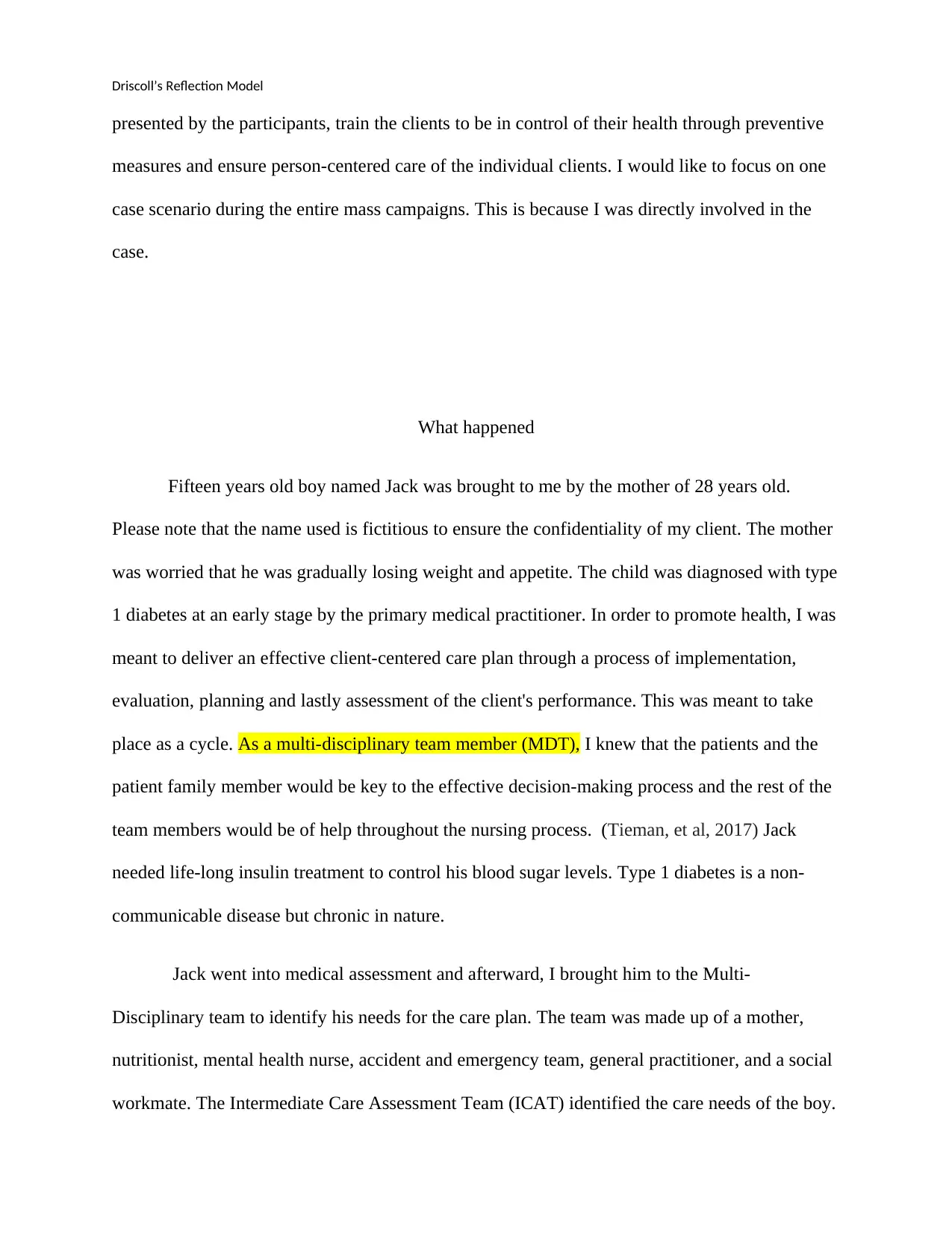
Driscoll’s Reflection Model
presented by the participants, train the clients to be in control of their health through preventive
measures and ensure person-centered care of the individual clients. I would like to focus on one
case scenario during the entire mass campaigns. This is because I was directly involved in the
case.
What happened
Fifteen years old boy named Jack was brought to me by the mother of 28 years old.
Please note that the name used is fictitious to ensure the confidentiality of my client. The mother
was worried that he was gradually losing weight and appetite. The child was diagnosed with type
1 diabetes at an early stage by the primary medical practitioner. In order to promote health, I was
meant to deliver an effective client-centered care plan through a process of implementation,
evaluation, planning and lastly assessment of the client's performance. This was meant to take
place as a cycle. As a multi-disciplinary team member (MDT), I knew that the patients and the
patient family member would be key to the effective decision-making process and the rest of the
team members would be of help throughout the nursing process. (Tieman, et al, 2017) Jack
needed life-long insulin treatment to control his blood sugar levels. Type 1 diabetes is a non-
communicable disease but chronic in nature.
Jack went into medical assessment and afterward, I brought him to the Multi-
Disciplinary team to identify his needs for the care plan. The team was made up of a mother,
nutritionist, mental health nurse, accident and emergency team, general practitioner, and a social
workmate. The Intermediate Care Assessment Team (ICAT) identified the care needs of the boy.
presented by the participants, train the clients to be in control of their health through preventive
measures and ensure person-centered care of the individual clients. I would like to focus on one
case scenario during the entire mass campaigns. This is because I was directly involved in the
case.
What happened
Fifteen years old boy named Jack was brought to me by the mother of 28 years old.
Please note that the name used is fictitious to ensure the confidentiality of my client. The mother
was worried that he was gradually losing weight and appetite. The child was diagnosed with type
1 diabetes at an early stage by the primary medical practitioner. In order to promote health, I was
meant to deliver an effective client-centered care plan through a process of implementation,
evaluation, planning and lastly assessment of the client's performance. This was meant to take
place as a cycle. As a multi-disciplinary team member (MDT), I knew that the patients and the
patient family member would be key to the effective decision-making process and the rest of the
team members would be of help throughout the nursing process. (Tieman, et al, 2017) Jack
needed life-long insulin treatment to control his blood sugar levels. Type 1 diabetes is a non-
communicable disease but chronic in nature.
Jack went into medical assessment and afterward, I brought him to the Multi-
Disciplinary team to identify his needs for the care plan. The team was made up of a mother,
nutritionist, mental health nurse, accident and emergency team, general practitioner, and a social
workmate. The Intermediate Care Assessment Team (ICAT) identified the care needs of the boy.
⊘ This is a preview!⊘
Do you want full access?
Subscribe today to unlock all pages.

Trusted by 1+ million students worldwide
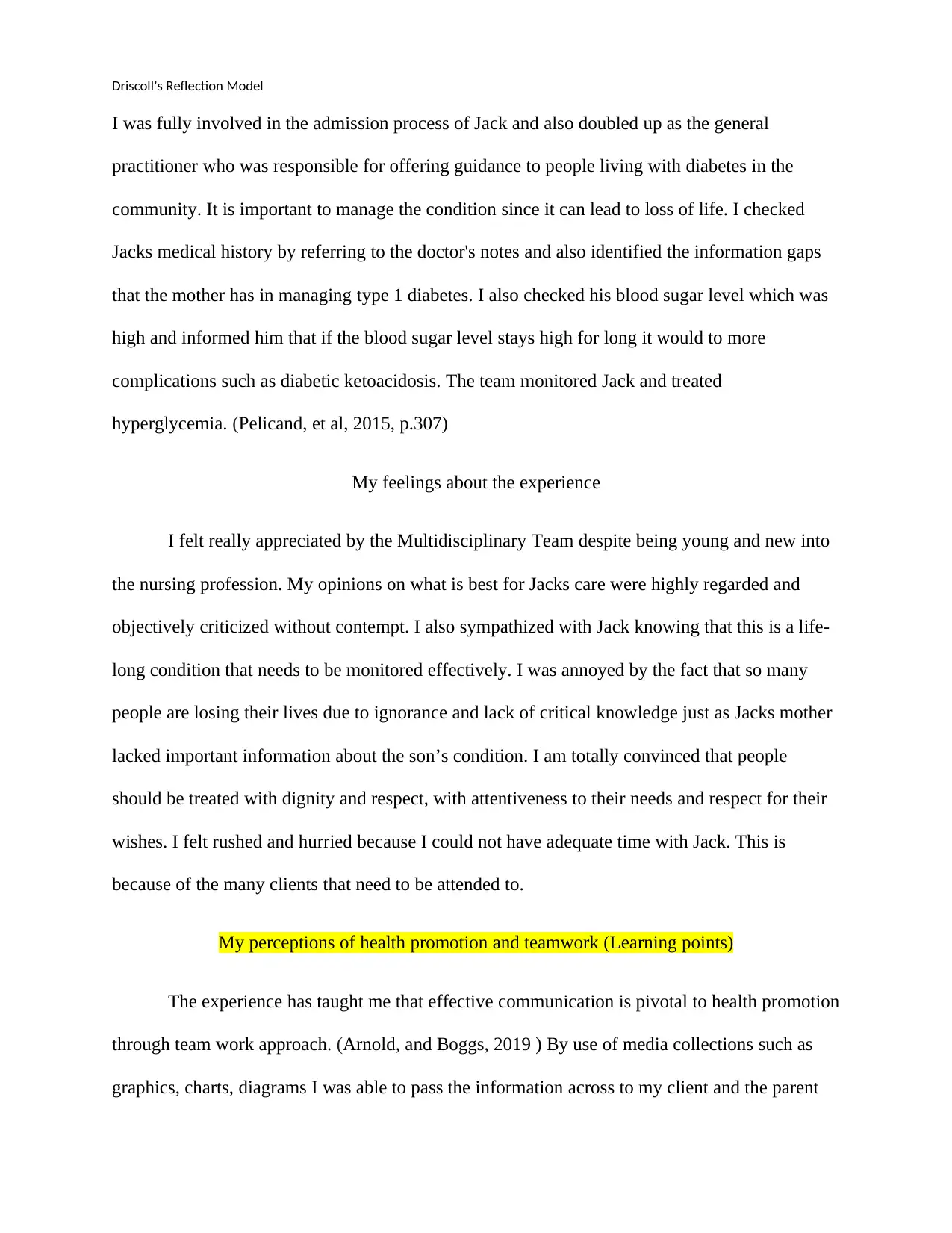
Driscoll’s Reflection Model
I was fully involved in the admission process of Jack and also doubled up as the general
practitioner who was responsible for offering guidance to people living with diabetes in the
community. It is important to manage the condition since it can lead to loss of life. I checked
Jacks medical history by referring to the doctor's notes and also identified the information gaps
that the mother has in managing type 1 diabetes. I also checked his blood sugar level which was
high and informed him that if the blood sugar level stays high for long it would to more
complications such as diabetic ketoacidosis. The team monitored Jack and treated
hyperglycemia. (Pelicand, et al, 2015, p.307)
My feelings about the experience
I felt really appreciated by the Multidisciplinary Team despite being young and new into
the nursing profession. My opinions on what is best for Jacks care were highly regarded and
objectively criticized without contempt. I also sympathized with Jack knowing that this is a life-
long condition that needs to be monitored effectively. I was annoyed by the fact that so many
people are losing their lives due to ignorance and lack of critical knowledge just as Jacks mother
lacked important information about the son’s condition. I am totally convinced that people
should be treated with dignity and respect, with attentiveness to their needs and respect for their
wishes. I felt rushed and hurried because I could not have adequate time with Jack. This is
because of the many clients that need to be attended to.
My perceptions of health promotion and teamwork (Learning points)
The experience has taught me that effective communication is pivotal to health promotion
through team work approach. (Arnold, and Boggs, 2019 ) By use of media collections such as
graphics, charts, diagrams I was able to pass the information across to my client and the parent
I was fully involved in the admission process of Jack and also doubled up as the general
practitioner who was responsible for offering guidance to people living with diabetes in the
community. It is important to manage the condition since it can lead to loss of life. I checked
Jacks medical history by referring to the doctor's notes and also identified the information gaps
that the mother has in managing type 1 diabetes. I also checked his blood sugar level which was
high and informed him that if the blood sugar level stays high for long it would to more
complications such as diabetic ketoacidosis. The team monitored Jack and treated
hyperglycemia. (Pelicand, et al, 2015, p.307)
My feelings about the experience
I felt really appreciated by the Multidisciplinary Team despite being young and new into
the nursing profession. My opinions on what is best for Jacks care were highly regarded and
objectively criticized without contempt. I also sympathized with Jack knowing that this is a life-
long condition that needs to be monitored effectively. I was annoyed by the fact that so many
people are losing their lives due to ignorance and lack of critical knowledge just as Jacks mother
lacked important information about the son’s condition. I am totally convinced that people
should be treated with dignity and respect, with attentiveness to their needs and respect for their
wishes. I felt rushed and hurried because I could not have adequate time with Jack. This is
because of the many clients that need to be attended to.
My perceptions of health promotion and teamwork (Learning points)
The experience has taught me that effective communication is pivotal to health promotion
through team work approach. (Arnold, and Boggs, 2019 ) By use of media collections such as
graphics, charts, diagrams I was able to pass the information across to my client and the parent
Paraphrase This Document
Need a fresh take? Get an instant paraphrase of this document with our AI Paraphraser
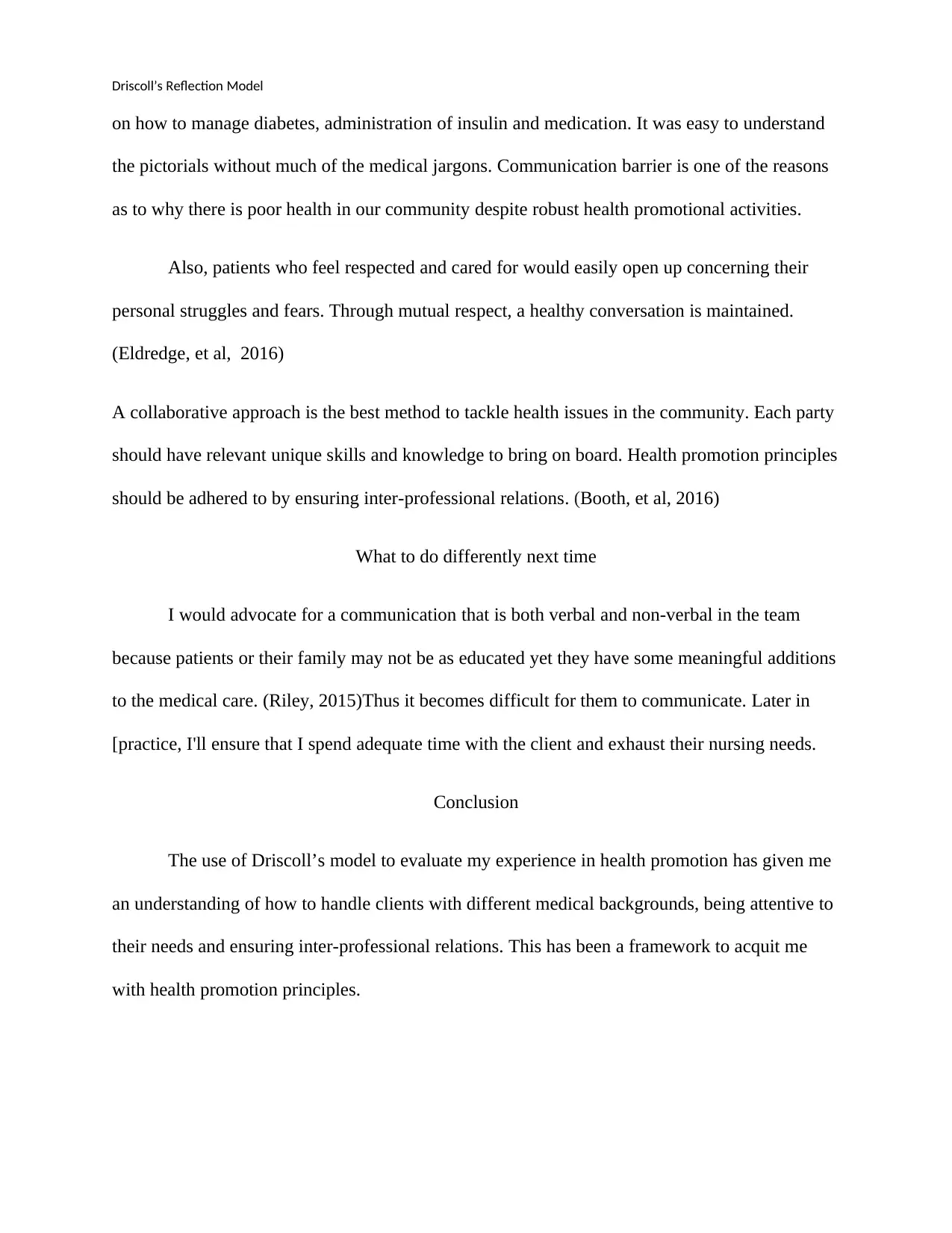
Driscoll’s Reflection Model
on how to manage diabetes, administration of insulin and medication. It was easy to understand
the pictorials without much of the medical jargons. Communication barrier is one of the reasons
as to why there is poor health in our community despite robust health promotional activities.
Also, patients who feel respected and cared for would easily open up concerning their
personal struggles and fears. Through mutual respect, a healthy conversation is maintained.
(Eldredge, et al, 2016)
A collaborative approach is the best method to tackle health issues in the community. Each party
should have relevant unique skills and knowledge to bring on board. Health promotion principles
should be adhered to by ensuring inter-professional relations. (Booth, et al, 2016)
What to do differently next time
I would advocate for a communication that is both verbal and non-verbal in the team
because patients or their family may not be as educated yet they have some meaningful additions
to the medical care. (Riley, 2015)Thus it becomes difficult for them to communicate. Later in
[practice, I'll ensure that I spend adequate time with the client and exhaust their nursing needs.
Conclusion
The use of Driscoll’s model to evaluate my experience in health promotion has given me
an understanding of how to handle clients with different medical backgrounds, being attentive to
their needs and ensuring inter-professional relations. This has been a framework to acquit me
with health promotion principles.
on how to manage diabetes, administration of insulin and medication. It was easy to understand
the pictorials without much of the medical jargons. Communication barrier is one of the reasons
as to why there is poor health in our community despite robust health promotional activities.
Also, patients who feel respected and cared for would easily open up concerning their
personal struggles and fears. Through mutual respect, a healthy conversation is maintained.
(Eldredge, et al, 2016)
A collaborative approach is the best method to tackle health issues in the community. Each party
should have relevant unique skills and knowledge to bring on board. Health promotion principles
should be adhered to by ensuring inter-professional relations. (Booth, et al, 2016)
What to do differently next time
I would advocate for a communication that is both verbal and non-verbal in the team
because patients or their family may not be as educated yet they have some meaningful additions
to the medical care. (Riley, 2015)Thus it becomes difficult for them to communicate. Later in
[practice, I'll ensure that I spend adequate time with the client and exhaust their nursing needs.
Conclusion
The use of Driscoll’s model to evaluate my experience in health promotion has given me
an understanding of how to handle clients with different medical backgrounds, being attentive to
their needs and ensuring inter-professional relations. This has been a framework to acquit me
with health promotion principles.
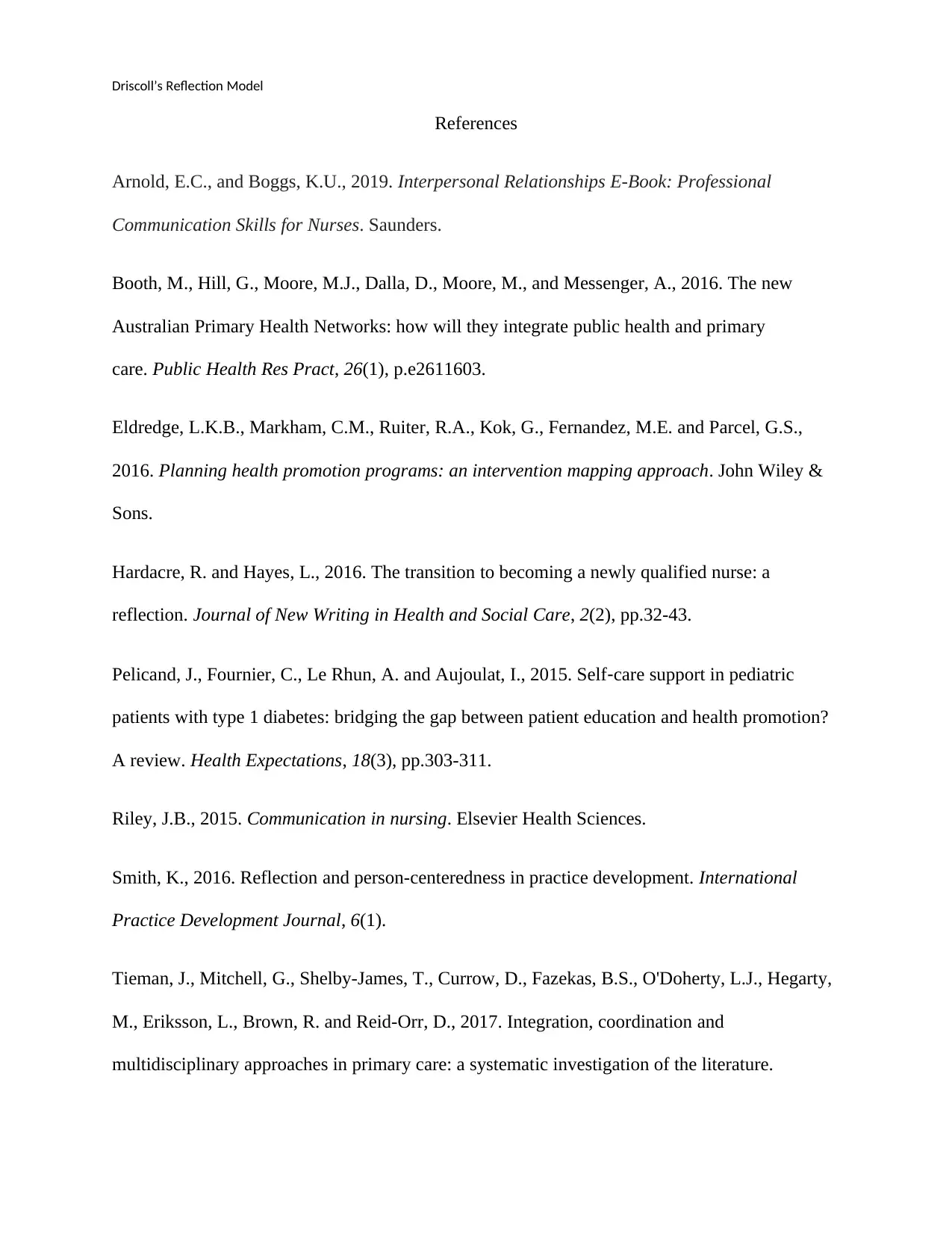
Driscoll’s Reflection Model
References
Arnold, E.C., and Boggs, K.U., 2019. Interpersonal Relationships E-Book: Professional
Communication Skills for Nurses. Saunders.
Booth, M., Hill, G., Moore, M.J., Dalla, D., Moore, M., and Messenger, A., 2016. The new
Australian Primary Health Networks: how will they integrate public health and primary
care. Public Health Res Pract, 26(1), p.e2611603.
Eldredge, L.K.B., Markham, C.M., Ruiter, R.A., Kok, G., Fernandez, M.E. and Parcel, G.S.,
2016. Planning health promotion programs: an intervention mapping approach. John Wiley &
Sons.
Hardacre, R. and Hayes, L., 2016. The transition to becoming a newly qualified nurse: a
reflection. Journal of New Writing in Health and Social Care, 2(2), pp.32-43.
Pelicand, J., Fournier, C., Le Rhun, A. and Aujoulat, I., 2015. Self‐care support in pediatric
patients with type 1 diabetes: bridging the gap between patient education and health promotion?
A review. Health Expectations, 18(3), pp.303-311.
Riley, J.B., 2015. Communication in nursing. Elsevier Health Sciences.
Smith, K., 2016. Reflection and person-centeredness in practice development. International
Practice Development Journal, 6(1).
Tieman, J., Mitchell, G., Shelby-James, T., Currow, D., Fazekas, B.S., O'Doherty, L.J., Hegarty,
M., Eriksson, L., Brown, R. and Reid-Orr, D., 2017. Integration, coordination and
multidisciplinary approaches in primary care: a systematic investigation of the literature.
References
Arnold, E.C., and Boggs, K.U., 2019. Interpersonal Relationships E-Book: Professional
Communication Skills for Nurses. Saunders.
Booth, M., Hill, G., Moore, M.J., Dalla, D., Moore, M., and Messenger, A., 2016. The new
Australian Primary Health Networks: how will they integrate public health and primary
care. Public Health Res Pract, 26(1), p.e2611603.
Eldredge, L.K.B., Markham, C.M., Ruiter, R.A., Kok, G., Fernandez, M.E. and Parcel, G.S.,
2016. Planning health promotion programs: an intervention mapping approach. John Wiley &
Sons.
Hardacre, R. and Hayes, L., 2016. The transition to becoming a newly qualified nurse: a
reflection. Journal of New Writing in Health and Social Care, 2(2), pp.32-43.
Pelicand, J., Fournier, C., Le Rhun, A. and Aujoulat, I., 2015. Self‐care support in pediatric
patients with type 1 diabetes: bridging the gap between patient education and health promotion?
A review. Health Expectations, 18(3), pp.303-311.
Riley, J.B., 2015. Communication in nursing. Elsevier Health Sciences.
Smith, K., 2016. Reflection and person-centeredness in practice development. International
Practice Development Journal, 6(1).
Tieman, J., Mitchell, G., Shelby-James, T., Currow, D., Fazekas, B.S., O'Doherty, L.J., Hegarty,
M., Eriksson, L., Brown, R. and Reid-Orr, D., 2017. Integration, coordination and
multidisciplinary approaches in primary care: a systematic investigation of the literature.
⊘ This is a preview!⊘
Do you want full access?
Subscribe today to unlock all pages.

Trusted by 1+ million students worldwide
1 out of 6
Related Documents
Your All-in-One AI-Powered Toolkit for Academic Success.
+13062052269
info@desklib.com
Available 24*7 on WhatsApp / Email
![[object Object]](/_next/static/media/star-bottom.7253800d.svg)
Unlock your academic potential
Copyright © 2020–2025 A2Z Services. All Rights Reserved. Developed and managed by ZUCOL.




